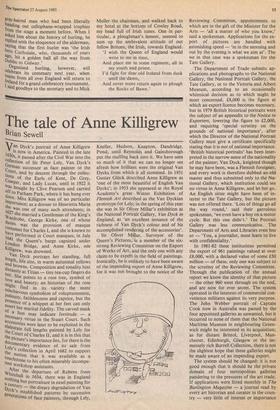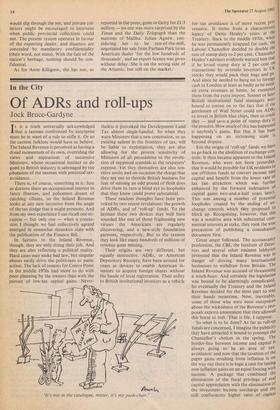The tale of Anne Killigrew
Brian Sewell
Van Dyck's portrait of Anne Killigrew is now in America. Painted in the late 1630s, it passed after the Civil War into the collection of Sir Peter Lely, Van Dyck's German successor as face painter to the Court, and by descent through the collec- tions of the Earls of Kent, De Grey, Cowper, and Lady Lucas, until in 1922 it Was bought by Clive Pearson and carried 0.11' to Parham Park, where it has hung ever sInce. Miss Killigrew was of no particular importance; as a dresser to Henrietta Maria she was one of many such attendants; in i „,1627 she married a Gentleman of the King's wardrobe, George Kirke, one of whose duties was the provision of masque costumes for Charles 1, and she is known to have performed in Court masques; in July 1641 the Queen's barge capsized under Landon Bridge, and Anne Kirke, née Killigrew, was drowned. Van Dyck portrays her standing, full length, life size, in warm autumnal yellows and browns. Composition and tonality hint distantly at Titian — tiny tea-cup fingers do not. She points to a rose tree, symbol of love and beauty; an historian of the rose might find in its variety the more mischievous symbolism of voluptuousness, Jealousy, faithlessness and caprice, but the Presence of a whippet at her feet can only assert her marital fidelity. The carved mask of a lion may indicate fortitude — a necessary virtue in the Stuart Court. Such accessories were later to be exploited in the elaborate full lengths painted by Lely for the Court of Charles 11, and it is in this that the Picture's importance lies, for there is the documentary evidence of its sale from LelY's collection in April 1682 to support the notion that it was available as a touchstone to his often miserably incompe- tent workshop assistants.
Whitehall the departure of Rubens from Whitehall in 1634, there was in England nothing
but portraiture in easel painting for a century —
the dreary degradation of Van Dyck's established patterns by successive generations of face painters, through Lely, Kneller, Hudson, Knapton, Dandridge, Pond, until Reynolds and Gainsborough put the stuffing back into it. We have seen so much of it that we can no longer see afresh how brilliant were the original Van Dycks from which it all stemmed. In 1931 Gustav Gluck described Anne Killigrew as 'one of the most beautiful of English Van Dycks'; in 1953 she appeared at the Royal Academy's great Winter Exhibition of Flemish Art described as the Van Dyckian prototype for Lely; in the spring of this year she was in Sir Oliver Millar's exhibition at the National Portrait Gallery, Van Dyck in England, as 'an excellent instance of the richness of Van Dyck's colour and of his accomplished rendering of the accessories'.
Sir Oliver Millar, Surveyor of the Queen's Pictures, is a member of the six- strong Reviewing Committee on the Export of Works of Art, and the only one with any claim to be expert in the field of paintings. Ironically, he is unlikely to have been aware of the impending export of Anne Killigrew, for it was not brought to the notice of the Reviewing Committee, appointments to which are in the gift of the Minister for the
Arts — 'all a matter of who you know,'
said a spokesman. Applications for the ex- port of pictures are handled with
astonishing speed — 'in in the morning and out by the evening is what we aim at'. The we in that case was a spokesman for the Tate Gallery.
The Department of Trade submits ap- plications and photographs to the National Gallery, the National Portrait Gallery, the Tate Gallery, or to the Victoria and Albert Museum, according to an occasionally whimsical decision as to which might be most concerned. £8,000 is the figure at which an export licence becomes necessary, but in 1979 British historical portraits were the subject of an appendix to the Notice to Exporters, lowering the figure to £2,000, and requiring 'special scrutiny on the grounds of national importance', after which the Director of the National Portrait Gallery must give a certificate specifically stating that it is not of national importance. 'British historical portraits' has been inter- preted in the narrow sense of the nationality of the painter; Van Dyck, knighted though he may have been, was a Flemish foreigner, and every work is therefore dubbed an old master and thus submitted only to the Na- tional Gallery, which institution could see no virtue in Anne Killigrew, and let her go. An English sitter might have been of in- terest to the Tate Gallery, but the picture was not offered there. 'Lots of things go all the way round,' said their garrulous spokesman, 'we even have a boy on a motor cycle. But this one didn't.' The Portrait Gallery was less communicative. The Department of Arts and Libraries even less so — 'You, a journalist, must learn to live with confidentiality.'
In 1981-82 these institutions permitted the export of 961 paintings valued at over £8,000, with a declared value of some £50 million — of these, only one was subject to the scrutiny of the Reviewing Committee. Through the publication of the annual report we know the identity of that picture — the other 960 went through on the nod, and are now for ever secret. The system operated in the interests of commercial con- venience militates against its very purpose. The John Webber portrait of Captain Cook now in Australia was passed by the four appointed galleries as unwanted, but it occurred to none of them that the National Maritime Museum in neighbouring Green- wich might be interested in its acquisition; as for distant Bristol, Liverpool, Man- chester, Edinburgh, Glasgow or the im- mensely rich Burrell Collection, there is not the slightest hope that these galleries might be made aware of an impending export.
The system should be changed: it is not good enough that it should be the private domain of four metropolitan galleries pandering to the pressures of the art trade. If applications were listed monthly in The Burlington Magazine — a journal read by every art historian and curator in the coun- try — very little of interest or importance
would slip through the net, and private col- lectors might be encouraged to intervene when public provincial collections could not. The present system operates in favour of the exporting dealer, and disasters are concealed by mandatory confidentiality (their word, not mine). With the fate of the nation's heritage, nothing should be con- fidential.
As for Anne Killigrew, she has not, as
reported in the press, gone to Getty for £1.3 million — no one was more surprised by the Times and the Daily Telegraph than the matrons of Malibu. Julian Agnew, con- sidering her to be run-of-the-mill, negotiated her sale from Parham Park to an American dealer 'for the low hundreds of thousands', and an export licence was given without delay. She is on the wrong side of the Atlantic, but still on the market.



































 Previous page
Previous page